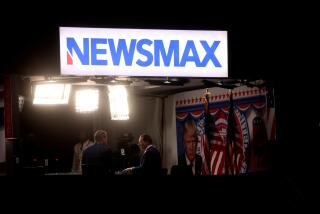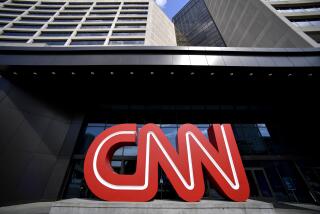CNBC Suffering Growing Pains : It Eliminated Rival FNN, but It’s Still Looking for an Image
- Share via
Tom Rogers, president of NBC’s cable division, is confidently ticking off the benefits of NBC’s $145-million winning bid for Financial News Network when, on the TV set against the wall, a CNBC anchorman reads a news item about the drop in broadcasting stocks.
The graphic illustrating the story says “TV Stocks” and shows little arrows pointing down next to the stock symbols for CBS Inc. and Capital Cities/ABC Inc. But the arrow next to General Electric Co.’s stock symbol points up. Rogers is happy.
“We only show GE on the uptick,” he jokes to a visitor about NBC’s parent company. But then Rogers’ smile turns to a frown as he studies the graphic. “Actually, that’s wrong,” he deadpans. “GE’s not a TV stock at all.”
Trial and error have been the order of the day at CNBC ever since NBC launched its cable-TV network dedicated to business and consumer news. But despite repeated attempts to win over new cable affiliates and subscribers, CNBC’s growth had stalled at only 18.2 million subscribers after 25 months on the air.
Now, thanks to the merger with FNN, CNBC has jumped to 43 million subscribers literally overnight, making it the 16th-largest cable-TV network. Previously, as the 25th-largest, CNBC could barely move the needle on the ratings meter.
“We’re now among the major cable networks and have passed the threshold to attract national advertising,” Rogers boasts.
Ironically, CNBC took over its stronger competitor, which was watched by twice as many viewers. FNN’s own financial problems were so extensive that there was no way it could have survived on its own.
“CNBC was struggling all along,” says Bill Croasedale, a media buyer at the Los Angeles advertising agency Western Media. “FNN was in the toilet too. The merger should enhance CNBC’s chance of making it.”
Such opportunity has not come without its price, however, thanks to a bidding war over FNN that erupted between NBC and a partnership formed by Dow Jones & Co. and Westinghouse Broadcasting.
In addition to the $145-million cash payment to buy FNN’s subscribers, NBC also assumed $9.3 million in liabilities and agreed to pay the seller half of any revenue exceeding $227 million over the next three years.
“When all the bills and start-up costs are added up, they’re pushing between a $250-million and $300-million investment by the time CNBC breaks even,” says Larry Gerbrandt, senior analyst with the media research firm Paul Kagan Associates. “But it’s what they had to pay to create a viable network long term.”
Despite its huge financial outlay, NBC did not buy FNN’s studio facilities or broadcast equipment and hired only 60 of FNN’s 300 employees.
Instead, the chief benefits were eliminating a competitor. “The guts of this whole transaction was to secure our distribution,” Rogers explains.
CNBC executives hope the wider distribution will lead to higher ratings--which so far have been paltry--and accelerate the network’s timetable toward profitability.
Before the FNN merger, CNBC attracted only about 35,000 households per hour. With the wider subscriber base, CNBC executives hope to double that.
For viewers, the only apparent change since the merger has been replacing CNBC’s stock ticker, which crawled across the bottom of the TV screen, with FNN’s ticker. During the day, the network now calls itself CNBC/FNN, although the FNN half of the title is dropped at night.
But except for adopting a few of FNN’s anchors and editorial staff, CNBC will continue its strategy of targeting hard-core business and financial news junkies during the day--a move that has worked--while trying to attract a broader audience in the evening--a move that has not.
“They really haven’t been able to make prime time click yet,” Gerbrandt says. “FNN tried sports, then financial news, then home shopping. Right now, CNBC is trying in-your-face TV, which may grab some attention but it’s not mainstream programming.”
Andy Friendly, who is in charge of programming CNBC’s evening programs, admits the cable network has had trouble developing prime-time shows that people want to watch. He says viewers have been confused by the dual nature of CNBC’s programming.
“The problem we had is that there was no clear identity to what we were doing,” Friendly says. “Now we’re trying to create a clear identity and niche.”
Friendly wants to fashion a consumer-oriented network at night and on weekends that does not appeal only to businessmen and retirees in Florida who follow the stock market. He has developed programs such as “Talk Live,” a sort of video version of talk radio with guest anchors from radio talk shows across the country.
Eventually, Friendly believes that the dual strategy will work, just as it does at Nickelodeon, which shows children’s programming during the day and switches to a campy lineup of old network sitcoms at night.
CNBC represents NBC’s biggest foray into the potentially lucrative cable-TV business. Unlike NBC, however, where more than $2 billion will be spent on programs this year, everything about CNBC is done on a shoestring.
The studios and offices, in an effort to hold down costs, are located in the blue-collar suburb of Ft. Lee, N.J., across the Hudson River from NBC’s glamorous Midtown Manhattan headquarters. Reporters and producers, who might make $150,000 a year for NBC, earn less than half that at CNBC.
If the cable network has a credo, in fact, it’s to produce programs as cheaply as possible. CNBC has budgeted only $30 million annually for its entire prime-time schedule--roughly what it costs to produce “Entertainment Tonight” or a hit network drama series for one season.
CNBC President Al Barber estimates that the network’s average half-hour programming cost runs in the “low thousands.” By contrast, a three-minute story on the network evening news can cost $20,000 to produce.
Such a tight-fisted approach on budgets has been dictated by the small audience that so far has been attracted to CNBC programs. A 30-second commercial, depending on what time of day it runs, costs between $200 and $2,000--rates that are similar to radio.
Barber, a burly executive who once managed General Electric’s railroad boxcar business, lectures about CNBC’s need to do more with less. “There are a lot of things we can do with our existing resources without additional costs,” he maintains.
He cites such “natural extensions” as business-to-business information services, newsletters, program production for other outlets such as syndication and satellites feeds into international markets.
Barber predicts that CNBC will be profitable on an operating basis within the next 12 months. “The upside comes in improving the ratings and performance during prime time and weekends,” he says. “It costs the same to program for the first subscriber as it does for the 40-millionth.”
Top 20 Cable-TV Networks The chart show the top 20 advertiser-supported cable-TV networks ranked by millions of subscribers. Figures are as of March 31.
Network Subscribers Network Subscribers 1 ESPN 58.2 11 Family Channel 52.8 2 CNN 58.0 12 Lifetime 52.5 3 TBS Superstation 56.4 13 Arts & Entertainment 50.2 4 USA Network 55.4 14 Weather Channel 48.7 5 Nickelodeon 54.6 15 Headline News 45.9 6 Discovery 54.5 16 CNBC 43.0 7 MTV 54.1 17 VH-1 41.1 8 C-SPAN 53.6 18 QVC 36.8 9 Turner Network Television 53.3 19 WGN (Superstation) 33.7 10 Nashville Network 53.0 20 American Movie Classics 32.0
Source: Paul Kagan Associates
More to Read
The biggest entertainment stories
Get our big stories about Hollywood, film, television, music, arts, culture and more right in your inbox as soon as they publish.
You may occasionally receive promotional content from the Los Angeles Times.










